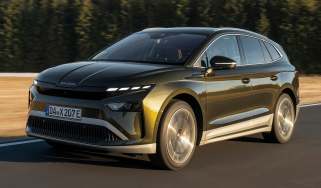Mitsubishi Outlander PHEV
We've been behind the wheel of the plug-in hybrid SUV that gives a glimpse of the future

This is Mitsubishi at its best – an expertly engineered car complete with tech to deliver the holy grail of performance, economy and few compromises. The EV range of 30 miles is a sensible commuting distance, and a punchy engine can cut in over longer trips. It works smoothly, too. With a sub-£30k price, this could be a winner.
The Mitsubishi i-MiEV electric car has been gearing us up for the main event: plug-in hybrids. The company reckons that models boosted by electricity will account for 20 per cent of sales by 2020, with PHEV (Plug-In Hybrid Electric Vehicle) versions of the ASX compact SUV and the next-generation Outlander SUV blazing the trail.
This prototype is the test bed for the latter, due in 2013. The PX-MiEV seen at the Tokyo Motor Show previewed the looks; now we get an early taste of what it will be like to drive. Three powerplants do the work: a 134bhp 2.0-litre petrol and two 80bhp electric motors – one in the front, one at the rear.
Video: watch CarBuyer's video review of the Outlander
[[{"type":"media","view_mode":"content_narrow","fid":"69226","attributes":{"alt":"","class":"media-image"}}]]
Here is how it works. At around 70mph, the engine is directly connected to the front wheels with electric power merely assisting. There’s only one gear, so when the engine is called on to help at lower speeds – for example when accelerating, instead of driving the wheels – it powers a generator to feed the electric motors.
Used - available now

2019 Volkswagen
Golf
103,461 milesAutomaticDiesel1.6L
Cash £8,999
2013 Mercedes
B-Class
97,000 milesAutomaticDiesel1.8L
Cash £5,499
2021 Hyundai
Ioniq hybrid
51,104 milesAutomaticPetrol1.6L
Cash £12,710
2025 Land Rover
Defender 90
29,453 milesAutomaticDiesel3.0L
Cash £51,990The process feels seamless from the driving seat. The idea is that for the first 30 miles the car can run on battery power, with only brief assists from the engine. In this way, Mitsubishi reckons that an astonishing 170mpg is possible.
That strong, smooth urge from standstill is muscular enough to avoid activating the petrol engine, and it takes a really heavy foot to wake the powerplant at all. At high revs it produces a harsh clatter that quickly dies, CVT-style, as you ease off. Over 30 miles or so, the engine is called on again to top up the batteries, but it runs so quietly at low revs that you don’t hear it.
The heavy batteries under the floor reduce the centre of gravity by 30mm (and ground clearance by 10mm), giving more stability. And while the final PHEV will certainly weigh more than a standard Outlander, it does claw back some of the deficit by shedding its alternator, starter motor and gearbox, as well as using a smaller flywheel. Electronics will make the newcomer safe, too, with the twin electric motors combining traction control with ESP.
Power delivered with economy and refinement is what makes the plug-in Outlander desirable. Its viability depends on the missing piece of the jigsaw – price.







